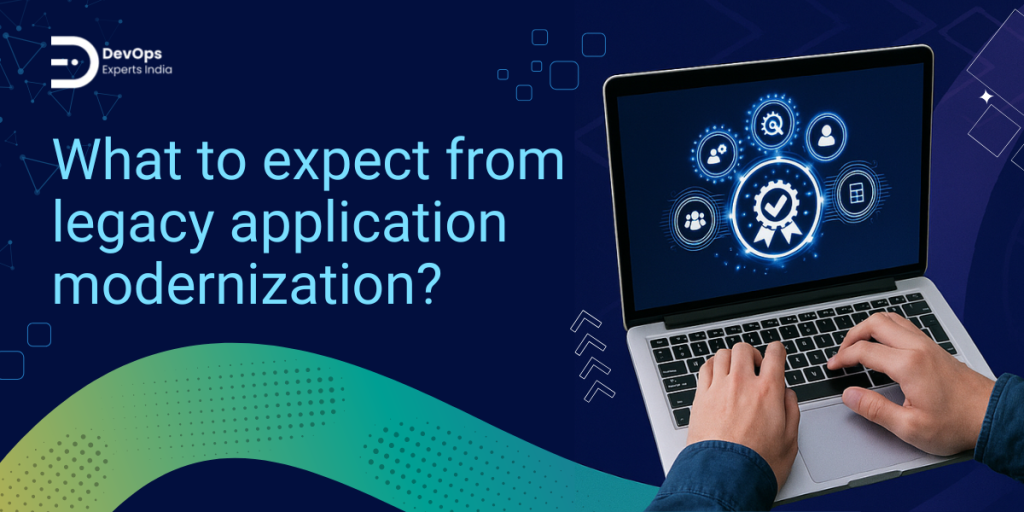No Doubts! Legacy systems have been the backbone of several businesses. However, relying on these outdated systems as a whole can significantly impact the business growth, security, and innovation. This is where legacy application modernization plays its critical role that making it a strategic approach to build a future-proof business.
So, in this guide, we’ll explore what legacy system modernization means, when, and why it requires modernization. You will also find the answer regarding how to approach modernization effectively, utilizing the 7 R’s. So, let’s begin with the research.
What is Legacy Application Modernization?
Legacy application modernization refers to the process of upgrading or transforming outdated software apps to ensure they work or operate efficiently. This modernization process may include refactoring the codebase, migrating to the cloud, enhancing UX/UI, or rebuilding the entire app with modern aspects.
So, instead of replacing the entire legacy system as a whole, modernization makes it possible for businesses to retain the core functionality while eliminating the technical debts that hold them back. Hence, Modernization could involve rehosting, re-platforming, or even just enhancing the existing application architecture.
Related Blog: Cloud DevOps: How DevOps and Cloud work together?
Some of the examples for legacy system modernization are as follows:
- A healthcare company has its core dependencies on a legacy system, i.e., a desktop-based patient management system. Therefore, with modernization, the company moved the entire system to a cloud-based application with mobile access and AI-assisted scheduling. Although the core functionality was maintained, the system transformed its operational aspects with quicker delivery, better user experience, and improved data handling.
- A prominent financial institution was utilizing COBOL-based mainframe apps. Through modernization, the process was transferred to a microservices architecture using modern APIs and integrated with real-time analytics to enhance its customer service with decision-making.
In these examples, legacy system modernization helped companies with faster systems with enhanced security aspects that meet current digital needs.
When is the Right Time for Modernizing Legacy Applications?
Globally, every company has initiated its journey of modernizing legacy applications, and thus, this is the time to go ahead with modernization. So, let’s discuss some signature that truly highlights that now is the time to modernize:
- Lagged Performance: Users continuously complain about slow load times with frequent downtime.
- High Maintenance Cost: IT teams spend a lot of time maintaining the innovation.
- Integration Challenges: Company systems struggle to cope with modern platforms or cloud services.
- Security Risks: Outdated or legacy systems lack compliance or are not supported by new security aspects or technologies.
- Limited Scalability: Legacy systems or outdated apps generally raise the concern of holding you back with business growth.
Business application modernization isn’t always urgent, but when systems begin to hinder innovation or customer experience, it’s time to take action.
Related Blog: DataOps Vs DevOps: What’s the Difference?
What to Expect from Legacy Application Modernization?

Thinking of modernization of legacy applications or outdated systems to a technical upgrade is unjustified, but it’s a business transformation. Let’s take what all benefits businesses can expect:
- Better Performance with Scalability: Through modernization, legacy applications will begin to execute faster, handle more users, and adapt to the evolving business growth.
- Enhanced Security with Compliance: With legacy system modernization, businesses with have system with updated technologies having stronger security frameworks and compliance features.
- Betterment of User Experience: Modern UX/UI designs have opened gateways for businesses to provide a more enjoyable or easier user interface for apps, especially for employees and customers.
- Cost Efficiency: Modernization will significantly reduce long-term operational costs by eradicating the concern about outdated infrastructure and inefficient codebases.
- Quick Innovation Cycles: With modernized systems, launching new features or entering new markets becomes faster and more manageable.
How to Modernize Legacy Applications?

Choosing a one-size-fits-all approach to modernization is somehow impossible. The right method somehow depends upon several factors like the app’s role, complexity, and business value. So, here we have 7 R’s that provides a solid framework:
- RETAIN: Keep the application as-is—only if it’s still serving its purpose well with minimal risk.
- RETIRE: Decommission applications that are obsolete or redundant.
- REHOST: Move your legacy app to a new infrastructure (like the cloud) without changing its core code. Fast and low risk.
- REPLATFORM: Move to a new runtime platform (e.g., cloud-native environments) with minor adjustments to improve performance.
- REFACTOR: Restructure and optimize the application’s internal code without altering its functionality—great for improving efficiency and maintainability.
- REARCHITECT: Change the application’s architecture to allow for better scalability and flexibility, such as moving from monolith to microservices.
- REBUILD: Completely rewrite the application to take full advantage of modern technologies. This is the most resource-intensive but allows full customization.
Selecting the right path initiates a thorough assessment of the current legacy systems and business objectives. There are several legacy application modernization service providers that can help your business with evaluation and recommend a suitable pathway.
Conclusion:
Legacy System Modernization is no longer a tech upgrade, but a strategic business approach to thrive in the digital age. The key is to modernize with intention, i.e., understanding current systems, setting up clear goals, and opting for the suitable pathway.
Choosing the right approach for modernizing legacy applications can help businesses unlock favorable business value, from quick innovations to security enhancements and customer satisfaction. Therefore, business application modernization is the bridge between where you are and where your business needs to be.
So, investing in legacy application modernization services now means future-proofing your operations, improving agility, and creating value at every digital touchpoint.






